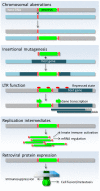Endogenous retroviruses and the development of cancer
- PMID: 24511094
- PMCID: PMC3925786
- DOI: 10.4049/jimmunol.1302972
Endogenous retroviruses and the development of cancer
Abstract
Mammalian genomes include a considerable number of endogenous retroviruses (ERVs), relics of ancestral infectious retroviruses, whose proviruses have invaded the germ-line. The documented ability of infectious retroviruses to cause cancer has greatly contributed to the discovery of ERVs. It also reinforced the concept that ERVs are causative agents of many cancers, a notion that historically has not always stood up to experimental scrutiny. The recent greater appreciation of the complexity of ERV biology and the identification of dedicated host mechanisms controlling ERV activity have revealed novel interactions between ERVs and their hosts, with the potential to cause or contribute to disease. In this review, the involvement of ERVs in cancer initiation and progression is discussed, as well as their contribution to our understanding of the process of transformation and to the invention of innovative preventive and therapeutic cancer treatments.
Figures


References
-
- Dewannieux M, Heidmann T. Endogenous retroviruses: acquisition, amplification and taming of genome invaders. Curr. Opin. Virol. 2013 doi: 10.1016/j.coviro.2013.08.005. - PubMed
-
- Feschotte C, Gilbert C. Endogenous viruses: insights into viral evolution and impact on host biology. Nat. Rev. Genet. 2012;13:283–296. - PubMed
-
- Stoye JP. Studies of endogenous retroviruses reveal a continuing evolutionary saga. Nat. Rev. Microbiol. 2012;10:395–406. - PubMed
Publication types
MeSH terms
Substances
Grants and funding
LinkOut - more resources
Full Text Sources
Other Literature Sources

